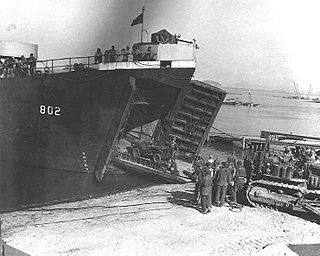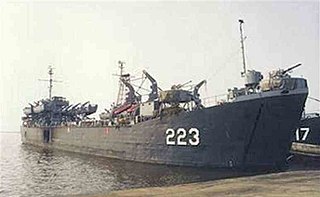
USS Talladega (APA/LPA-208) was a Haskell-class attack transport of the US Navy. She was of the VC2-S-AP5 Victory ship design type. Talladega was named for Talladega County, Alabama.
USS ''LST-84'' was one of the hundreds of Tank landing ships built during World War II to support amphibious military operations. Her role was to carry significant quantities of vehicles, cargo, and troops directly onto an unimproved shore. The ship was sponsored by Mrs. W. Raymond Brendel. The ship was constructed inland at Jeffersonville, Indiana, by the Jeffersonville Boat & Machine Co. as coastal ship yards were used to build larger naval vessels. The ship traversed the Ohio and Mississippi River to reach open water.

USS Mifflin (APA-207) was a Haskell-class attack transport in service with the United States Navy from 1944 to 1946. She was scrapped in 1975.

USS Logan (APA-196) was a Haskell-class attack transport of the United States Navy, named for counties in Colorado, Illinois, Kansas, Kentucky, Ohio, Oklahoma, Nebraska, North Dakota, and West Virginia. The Haskell-class design, United States Maritime Commission standard type VC2-S-AP5, is a sub type of the World War II Victory ship design.

USS Luzon (ARG-2) was an internal combustion engine repair ship in service with the United States Navy from 1943 to 1947 and from 1950 to 1960. She was the lead ship in a class of twelve ships and was scrapped in 1974.

USS Wabash (AOG-4) was a Patapsco-class gasoline tanker acquired by the U.S. Navy for the dangerous task of transporting gasoline to warships in the fleet, and to remote Navy stations.

USS Douglas County (LST-731) was an LST-542-class tank landing ship built for the United States Navy during World War II. Named after counties in 12 states, she was the only U.S. Naval vessel to bear the name.

The USS Duval County (LST-758) was an LST-542-class tank landing ship that was built for the United States Navy during World War II. Named after counties in Florida and Texas, she was the only U.S. naval vessel to bear the name.
USS Garfield County (LST-784) was an LST-542-class tank landing ship built for the United States Navy during World War II. Named after counties in Colorado, Montana, Nebraska, Oklahoma, Utah, and Washington, she was the only U.S. Naval vessel to bear the name.

USS Hamilton County (LST-802) was an LST-542-class tank landing ship built for the United States Navy during World War II. Named after counties in Florida, Illinois, Indiana, Iowa, Kansas, Nebraska, New York, Ohio, Tennessee, and Texas, she was the only U.S. Naval vessel to bear the name.

USS Hickman County (LST-825) was an LST-542-class tank landing ship built for the United States Navy during World War II. Named after counties in Kentucky and Tennessee, she was the only U.S. Naval vessel to bear the name.

USS Iron County (LST-840) was an LST-542-class tank landing ship built for the United States Navy during World War II. Named after counties in Michigan, Missouri, Utah, and Wisconsin, she was the only U.S. Naval vessel to bear the name.

USS Monmouth County (LST-1032) was an LST-542-class tank landing ship built for the United States Navy during World War II. Named after Monmouth County, New Jersey, she was the only U.S. Naval vessel to bear the name.

USS Bolster (ARS-38) was a Bolster-class rescue and salvage ship acquired by the U.S. Navy during World War II and remained in service during the Korean War and the Vietnam War. Her task was to come to the aid of stricken vessels.
USS LST-70 was an LST-1-class tank landing ship in the United States Navy. Like many of her class, she was not named and is properly referred to by her hull designation. LST-70 was manned by a United States Coast Guard crew throughout the Second World War.

USS LST-724 was an LST-542-class tank landing ship acquired by the U.S. Navy during World War II for the task of landing troops and supplies on enemy beachheads.

USS Oneida (APA-221) was a Haskell-class attack transport in service with the United States Navy from 1944 to 1946. She was scrapped in 1975.
USS LST-713 was an LST-542-class tank landing ship built for the United States Navy during World War II.

USS LST-716 was an LST-542-class tank landing ship in the United States Navy during World War II. She was transferred to the Republic of China Navy as ROCS Chung Chien (LST-205).

USS LST-399 was an LST-1-class tank landing ship in the United States Navy during World War II.
















